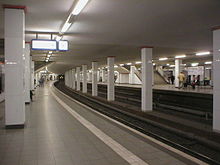S-Bahn station
As S-Bahn (abbreviated S-Bf , partly S-Bahn ) are mainly in Germany Stations of suburban trains called. In many cases, the meaning and use of the term is also extended to include S-Bahn stops , so that - technically imprecise - all access points on an S-Bahn line are referred to as S-Bahn stations.
Categorization
Since urban express trains often connect inner-city areas with the surrounding area of a city, S-Bahn stations can be differentiated into urban railway stations and those in the surrounding area.
While the distance between the S-Bahn stations or S-Bahn stops in the inner city area is often quite small, it is usually significantly larger in the suburban area.
Sometimes S-Bahn stations are located underground in inner-city areas, so that the S-Bahn has something in common with the U-Bahn . In the outskirts of large cities, S-Bahn stations are mostly on the surface and sometimes also serve as a transfer option for regional transport that extends further into the surrounding area .
Historical consideration
While S-Bahn stations, which were opened in the 19th century or at the beginning of the 20th century, mostly had similar features to classic stations, for example a reception building, stations of light rail vehicles were later often adapted to their purpose and consist only of (partially) covered platforms and their entrances.
literature
- Jürgen Meyer-Kronthaler: Berlin's S-Bahn stations . Be.bra-Verlag, Berlin 1998, ISBN 3-930863-25-1

